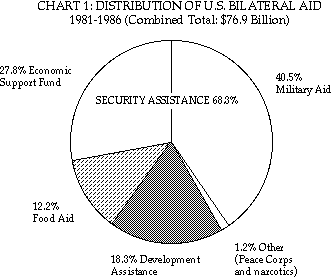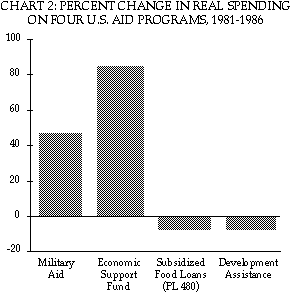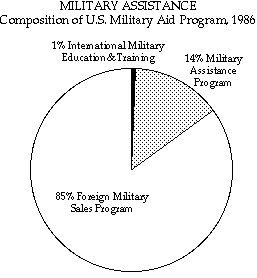Frances Moore Lappé is the author of Diet for a Small Planet and a founder of the Institute for Food and Development Policy – better known as Food First. In this excerpt from the Institute’s recent book, Betraying the National Interest, she and her co-authors challenge us to a deeper understanding of U.S. foreign aid and its impact on both global security and the Third World.
Despite the generosity and goodwill of most Americans, U.S. foreign aid isn’t working. If its goal is to alleviate poverty abroad, we search in vain for evidence of its success. Among major recipients of U.S. aid – the Philippines, India, and Central American nations, for example – the number of people living in poverty has climbed as foreign aid has increased. Even government-sponsored studies admit that many of the best-sounding projects to help the poorest people often fail to reach them.
If, on the other hand, the goal of U.S. aid is to heighten national security by stabilizing foreign governments and tying them more closely to us, then it is also failing. Since the early 1970s, many of the U.S. government’s long-standing allies into which it plowed billions of dollars in aid have fallen – including the Shah of Iran, Somoza of Nicaragua, Marcos of the Philippines, and Haile Selassie in Ethiopia.[1] Others – particularly Pakistan, Zaire, Honduras, El Salvador – now have little or no more popular support than did those deposed regimes.
But our goal is not simply to decry foreign aid’s failures. It is to find out why it fails. In even setting out on such a search, however, we face a major obstacle: a worn-out, stale debate lies waiting to trap us.
On one side are those who decry U.S. aid’s stinginess, pointing out – correctly – that the United States provides a lower percentage of its Gross National Product (GNP) in foreign aid than any other western nation. More substantively, they call for the United States to reform its aid program, shifting its focus from our military-dominated security interests to other humanitarian concerns. Foreign aid should be an expression of our generosity, not a weapon of influence or war.
On the other side, many argue that sentiment mixed into the art of statecraft can be dangerous. Given real-world geopolitics, we cannot afford to let humanitarian concerns dictate the distribution of our aid. America has a lot to offer other nations, they maintain, but we will have nothing to give if we don’t look out for ourselves first. This means using foreign aid as a deliberate arm of foreign policy to keep friendly governments in power. It also means using aid to influence others toward specific policies favorable to us.
In bare outline, these positions define the debate. Unfortunately, they also limit it by encouraging us to ask the wrong questions. How can we reform aid so that it serves the interests of the poor abroad instead of U.S. interests? Or, how can we use aid more effectively as a weapon to keep governments in power which pledge allegiance to the United States?
The very premises of both positions are flawed. The humanitarians opt for concern for others, while the realists would put us first. But we suggest – being unflinchingly realistic – that it is impossible to divide these interests. Even to see the possibility, however, of constructing a foreign aid policy on the basis of common interests takes some hard thinking. One must consider just what are the needs of the majority of people now poor, hungry, and illiterate in the third world. What is the root of their poverty and what is necessary to overcome it?
In our books Food First: Beyond the Myth of Scarcity[2] and World Hunger: Twelve Myths,[3] we have tried carefully to document how people are made hungry. In virtually every country, either current production or yet untapped local potential could meet the needs of the entire people. Thus, too many people or the unfortunate calamities of nature do not cause hunger. Hunger is human-made. It occurs where economic and political rules and institutions have so constricted control over farmland and other basic resources that some people are left with no power at all, not even to secure their most elementary human needs.
If this analysis of the social roots of hunger – now broadly accepted [4] – is true, then hunger cannot be addressed except through far-reaching change, change which shifts power to those who now have none. This is the first interest of the poor and hungry – an interest in society-wide change toward more dispersed, more democratic access to resources.
But what of ourselves? What are our overriding interests? High on the list is economic security – the need for remunerative and reliable work. As our economy becomes increasingly dominated by globe-spanning corporations in the 1980s, it is clearer than ever that poverty in the third world directly threatens that interest. As long as workers there are prevented from organizing to protect their interests, U.S. wages and jobs are jeopardized by American companies relocating to low-wage havens abroad. Moreover, if third-world people are kept too poor to buy even basic goods, much less amenities, U.S. producers are denied many millions of third-world customers.
There is a further, more subtle threat. In third-world societies where the majority are too poor to buy the products produced in their own fields and factories, large growers, businesspeople, and governments will increasingly orient production toward export markets. Without customers at home, no local market can be profitable enough for them. This intensified push to export will continue to undercut markets for U.S. producers, especially those of American farmers.
Beyond our economic well-being, Americans have an interest in physical security, a need to defuse an increasingly volatile world – four times as many people have been killed in wars and other civil conflicts during the forty years since World War II as in the forty years preceding it.[5] Just as with economic security, we contend that the legitimate interest of Americans in reduced violence cannot be achieved as long as half the world’s people are deprived of life’s essentials. As long as people are made to go hungry, the level of conflict in the world can only rise.
Bluntly stated, it takes violence to keep people hungry. People do not continue watching loved ones die needlessly of hunger. They resist. In many countries, religious movements stressing innate human rights fortify their demands: "As a child of God," a Nicaraguan peasant leader told us, "I learned that I have the right to live and that means the right to have land so that my family won’t starve." No amount of U.S. military aid used to suppress them will convince the poor to acquiesce. "I stand for peace," the peasant told us, "but not peace with hunger."
Thus, even if we could live with ourselves in a world increasingly split between surfeit and hunger, we would also have to live with greater instability, with more resources poured into military interventions in the third world. And we would have to live with the resulting hostility from those who see their rights denied with the assistance of U.S. weapons. National security based on fear of change inevitably means less and less security for us.
From this perspective, seeing the unity – or at least the overlapping – of interests appears not only possible but crucial. Both they and we would gain from far-reaching change in many third-world countries, where resources are today so tightly held.
For the most part, however, those defining U.S. national security since World War II have perceived our interests very differently. To them, our national interest is an ideological and military victory over a "red menace," or, more recently, an "evil empire." From their vantage point, any serious movement for change in the third world threatens the United States in two ways: first, the political opening that such change entails provides room for the Soviet Union to gain influence; second, any change that addresses the roots of hunger must have economic restructuring high on its agenda – democratizing control of land, credit, the national budget, and so on. U.S. policymakers have labeled any such agenda a "communist threat" because it inevitably challenges the sanctity of the market and the prerogatives of wealth.
This definition of the national interest, one that automatically construes far-reaching change as a threat to U.S. interest, subverts the potentially positive contribution of U.S. foreign aid programs.
AN AID POLICY BLINDED BY DOGMA
U.S. bilateral aid is aid flowing directly from the United States to governments abroad. The United States controls bilateral assistance directly. Therefore, it is the clearest indicator of the goals and priorities of U.S. foreign policy.

Most U.S. bilateral foreign aid is of three types, but its priorities are abundantly clear in the concentration of our aid dollars. With both economic and military components, security assistance now comprises two-thirds of U.S. foreign aid, and is the fastest growing part. Security assistance makes no pretense of targeting the needs of the poor. Its purpose is to "stem the spread of economic and political disruption and to help allies in dealing with threats to their security and independence."[6] So explains the Agency for International Development (AID), responsible for implementing most U.S. aid programs. Our government’s own rhetoric is thus clear on this point: security assistance is to help protect the status quo.
Economic Support Funds (ESF) also serve this function. Growing 84% in real terms between 1981 and 1986 (see Chart 2 below), less than 10% of U.S. tax dollars transferred abroad under this program goes to countries designated "low income" by the World Bank. 42% goes to countries considered "upper middle income." Not only is the direction of ESF support unrelated to the poverty of the recipient, but it rewards many antidemocratic regimes actively resisting reforms that might allow our aid to benefit the poor. Aid that is theoretically economic often becomes just another arm of U.S. military assistance – the biggest component of U.S. foreign aid.

Swelling forty-eight percent during the first half of the eighties, military assistance now comprises 41% of all our aid.[7] U.S. military aid, we have learned, is not just about shipping arms abroad. It is integrated into a comprehensive U.S. strategy – largely unseen by the American people – to intimidate dissidents and to quell insurgences against third-world governments that the United States deems allies. The militarization of foreign aid is a key element in a wider pattern of growing military dominance of foreign policy. Unable to grasp the roots of rebellion against the status quo in the third world, Washington uses our aid dollars in a futile effort to stave off that resistance. Such attempts to solve social problems with military strategy not only fail but backfire.
While security assistance has been growing, the remaining programs – development assistance, and food aid – have diminished. They now comprise eighteen and 12% of our aid respectively. Though their impact is therefore smaller, their function is still eye-opening. While U.S. development assistance may appear more effective in addressing third-world poverty than the hard-nosed approach of security assistance, it is nonetheless stymied by the same internal contradiction. Even the best-intended project cannot touch the root of rural people’s hunger and poverty if it is unable to challenge the structure of control over resources that impoverished them to begin with. Similarly, food aid appears to most Americans as the unmitigated good counter-balancing military aid. Yet most food aid flows as another means of budgetary support for favored U.S. allies. And food aid, it turns out, has additional drawbacks as a tool for positive change abroad.
Exploring U.S. development assistance and food aid pushes us to think critically about the very meaning of development itself – and how and by whom it can be achieved. Moreover, understanding both programs is vital to grasping how our government views our interests.
ECONOMIC DOGMA AND FOREIGN AID
Our government’s view of the world as a battleground between"them" and "us" not only contributes to a military-dominated foreign policy but powerfully shapes the content of the strictly economic portion of U.S. foreign aid. Washington believes that any economic system not like ours, must be like theirs. Economies are either capitalist or communist. Thus, the United States must use its foreign aid program as a lever to reform third-world economies – to make them more open to foreign investment and market-oriented like ours. The buzz-word is privatization – reducing the government’s role in the economy. Increasingly, U.S. aid to third-world governments is awarded on the basis of just such "policy reforms."
In many cases, basic economic reform is needed – badly needed. But Washington’s dogmatic stance prevents it from seeing that the prerequisites for the success of its economic formula simply do not exist in many third-world countries. How can the magic of the marketplace, for example, work to end hunger if the customers are missing – that is, if people are too poor to be part of the market? How can private enterprise free people from hunger in the third world if private capital is actually fleeing Africa and Latin America in search of surer investments elsewhere?
FOREIGN AID BUILT ON COMMON GROUND
Thus, we are not suggesting that a reform of foreign aid requires selfless humanitarianism. It demands something more profound: that as Americans we reconceive our national interest. Could we as a people come to see that the challenge of effective foreign aid is not to advance the interest of the poor abroad over those of Americans, or vice versa? Could we come to perceive the unity of interests of most Americans with those who are made to go hungry in the third world?
In the second half of the 1980s, surely the deepening suffering and growing violence in the third world suggest that the postwar keep-the-lid-on-change stance of our foreign aid policies needs reappraisal. The stakes are high. Once U.S. foreign policy, and in particular U.S. foreign aid, is narrowly predicated on a Soviet expansionist threat, virtually any action by our government is justified – no matter how it violates American democratic values or counters the needs of the hungry for change. Surely we cut our own throats when we allow our government to side with elites against the demands of the poor or engage in state terrorism against poor countries. Such policies undermine U.S. credibility throughout the world and threaten to drive third-world peoples to the Soviets for their very survival. More subtle, but equally central to our well-being, such an approach to foreign aid necessitates heightened government secrecy, undermining the very democracy it claims to be defending.
Americans should see behind the reassuring rhetoric and official rationales in order to understand why U.S. foreign aid is failing. Once the false premises of U.S. policies are understood, we believe Americans will perceive U.S. foreign aid as nothing less than a betrayal of the national interest. And with this insight, they will be prepared to undertake the profound rethinking of our real interests that must precede a redirection of U.S. aid programs.
NOTES
1. Others include Lon Nol of Cambodia, Thieu of South Vietnam, Tolbert of Liberia, Duvalier of Haiti, and Numieri of Sudan.
2. Frances Moore Lappé and Joseph Collins with Cary Fowler, Food First: Beyond the Myth of Scarcity (New York: Ballantine, 1979).
3. Lappé and Collins, World Hunger: Twelve Myths (San Francisco and New York: Food First Books/Grove Press, 1986).
4. Even the World Bank acknowledges that the main cause of hunger is poverty and the human institutions that perpetuate it. See Poverty and Hunger: Issues and Options for Food Security in Developing Countries (Washington, D.C.: World Bank, 1986).
5. Ruth Leger Sivard, World Military and Social Expenditures 1985 (Washington D.C.: World Priorities, 1985), 9.
6. AID, Congressional Presentation. FY 1987, main vol., 99.
7. As our book, Betraying the National Interest, was going to press in late 1986, Congress cut foreign aid by about 8%, trimming military aid by 14%. These cuts did not emerge, however, from public or congressional protest over the types of critical issues raised here. Pushed by the Gramm-Rudman-Hollings legislation, Congress was simply slashing those budget items – like foreign aid – least likely to bring them political repercussions. Despite these cuts, the thrust of our foreign aid policies remains unchanged.
U.S. Military Aid Programs:
An Overview
 The U.S. military aid program has three main components, each with a slightly different function. Many countries receive more than one type of military aid.
The U.S. military aid program has three main components, each with a slightly different function. Many countries receive more than one type of military aid.
Foreign Military Sales Program: FMS provides loans and grants to foreign governments to purchase U.S. military arms and training. It accounts for the lion’s share of U.S. military aid – over 85% in 1986. Although most loans are offered at market rates of interest, concessional rates have become increasingly common.
Military Assistance Program: MAP accounted for about 14% of military assistance in 1986. It also provides funds for the purchase of American-made arms, but it consists of grants instead of loans. Major MAP recipients in the first half of the 1980s include Turkey, Portugal, El Salvador, and Honduras, with the Central African Republic, Colombia, Ecuador, Guatemala, and Uruguay slated to become recipients in 1987.
International Military Education and Training Program: IMET is used to provide military training to foreign armed forces. Despite its small size, IMET reaches a great many countries. In 1986, for instance, eighty-five different countries received this form of military aid. During the last thirty-five years, IMET has trained over 500,000 military personnel in more than 100 countries.






